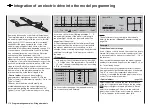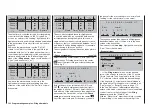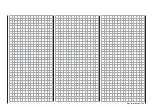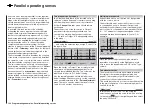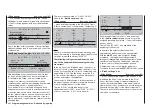
288
Programming examples - Using fl ight phases
Using fl ight phases
Up to 8 different fl ight phases (fl ight conditions) can
be programmed with settings independent of one
another within each the model memory.
Each of these fl ight phases can be called with
a switch or a switch combination. This makes it
possible to program different settings for various fl ight
states, such as «Normal», «Thermal», «Speed»,
«Distance», etc., then make in-fl ight changeovers
in a most convenient manner. However, with the
fl ight phase programming you can also make slight
modifi cations, e.g. of mixers, to try out by switching
during the fl ight in order to fi nd the optimal settings
for each model more easily.
Before actual programming of fl ight phases can
begin, consideration should be given to whether
the digital trimming of transverse, altitude and side
should be "GL(obal)" – in other words, applicable to all
fl ight phases – or per "PH(ase)" – in other words, each
fl ight phase individually variable.
If you decide in favor of a phase-specifi c trimming of
the elevator, for example, switch the menu …
»Stick mode«
(page 104)
… and change the standard "global" default accordingly.
The same applies for the number of trimming steps in
the "Tr. step" column:
global
Channel 1
Aileron
Elevator
Rudder
Trim
0.0s
Tr. step
– time +
global
0.0s
global
0.0s
global
0.0s
0.0s
0.0s
0.0s
0.0s
4
4
4
4
Example 1 …
… continuing with the previous programming of
an electric glider with 2 aileron servos.
AI
AI
EL
RU
Control of the electric motor is accomplished,
independent of the C1 joystick, with one of the two
side proportional rotary controls or one of the two
standard 3-way switches mounted into the switch
panels. The motor's speed control is connected to
receiver output 8 as described on page 276 and
continued in Examples 1 and 2 This is why "none"
was selected for the "Motor on C1" line in the »
Model
type
« menu. This not only causes the column "Motor"
in the »
Phase settings
« menu to be unavailable
but also allows all options to be available without
restriction in the "Brake settings" sub-menu of the
»
Wing mixers
« menu.
1
st
Step
»Phase settings«
(page 142)
Phase 1
Phase 2
Phase 3
Phase 4
Phase 5
0.1s
0.1s
0.1s
0.1s
0.1s
Name
Timer
Sw.time
–
–
–
–
¾
Nor mal
Ther mal
Speed
Launch
Initially, one or multiple fl ight phases are provided
with a specifi c identifi cation ("Name") for the
respective fl ight status. This identifi cation has no
infl uence on the programming of the transmitter; it
only serves for an improved differentiation of the
individual fl ight phases and is shown later in all fl ight-
phase dependent menus and in the base screen.
The selection of the respective line, a name and the
setting of the switchover time is done in the "usual"
manner, with a tap on the appropriate key(s) of the
two four-way touch pads.
Note:
With the exception of Phase 1, which should always
be assigned with the name "Normal" since it is
always active, if the fl ight phases are deactivated, it
is completely irrelevant which name is assigned to
which phase!
In everyday use by a model pilot, three to a maximum
of four fl ight phases are usually completely suffi cient:
"Start" with the climb settings
•
"Thermal" for "Flying high",
•
"Normal" for normal conditions and
•
"Speed" for high gear.
•
In the "Sw.time" column (switching time) …
Phase 1
Phase 2
Phase 3
Phase 4
Phase 5
1.0s
0.1s
0.1s
0.1s
0.1s
Name
Timer
Sw.time
–
–
–
–
¾
Nor mal
Ther mal
Speed
Launch
… a "blend-in" time can be established for the time in
which a changeover from any other fl ight phase into
this given fl ight-phase is to be accomplished in order
to permit a "smooth" transition for different servo
Summary of Contents for 32032
Page 1: ...33020 mc 20HoTT 2 en Programming Manual o Pro Pro mc 20 mc 20...
Page 15: ...15 For your notes...
Page 21: ......
Page 27: ...27 For your notes...
Page 41: ...41 For your notes...
Page 53: ...53 For your notes...
Page 59: ...59 For your notes...
Page 63: ...63 For your notes...
Page 93: ...93 For your notes...
Page 97: ...97 For your notes...
Page 141: ...141 How is a ight phase programmed...
Page 145: ...145 For your notes...
Page 155: ...155 For your notes...
Page 175: ...175 For your notes...
Page 203: ...203 For your notes...
Page 219: ...219 For your notes...
Page 253: ...253 For your notes...
Page 283: ...283 For your notes...
Page 321: ...321 For your notes...
Page 322: ...322 For your notes...
Page 323: ...323 For your notes...



